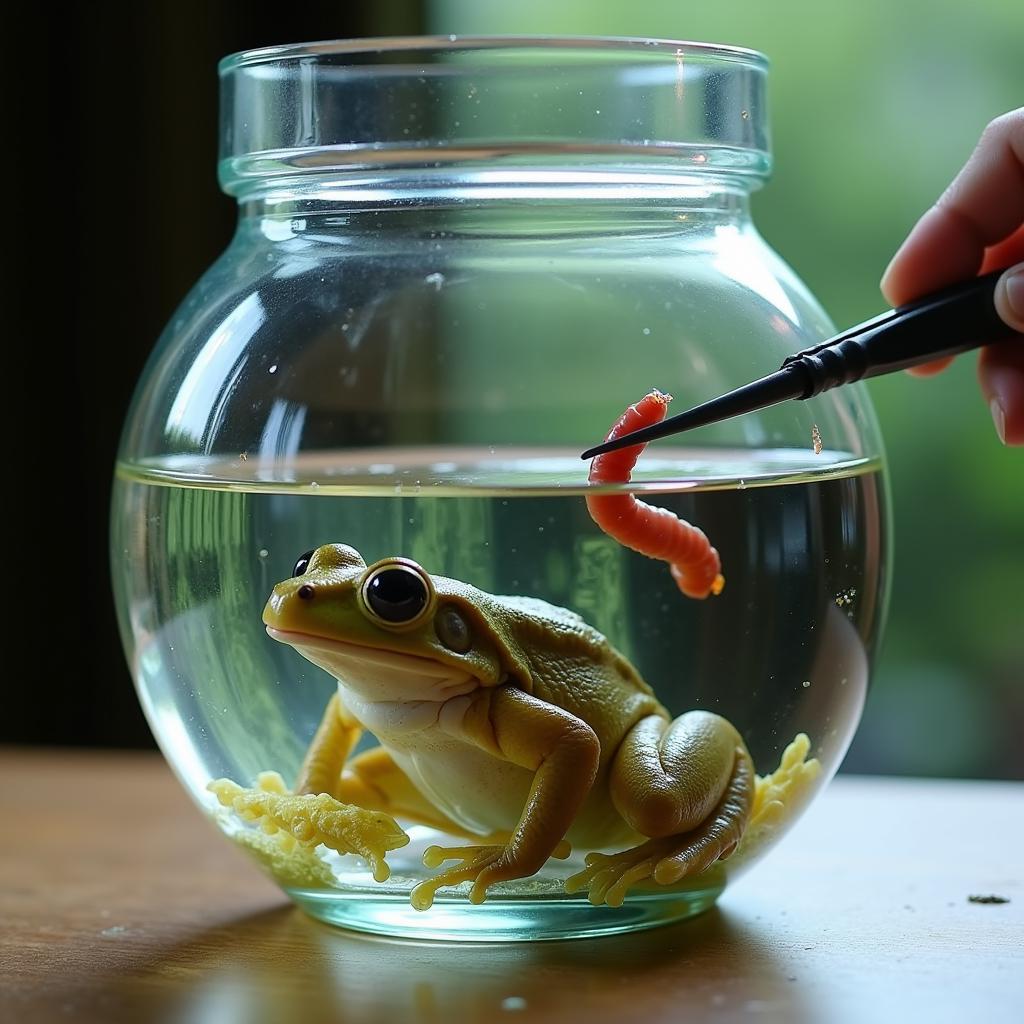African Clawed Frog Eating: A Guide to Their Diet and Feeding Habits
The African clawed frog, often a curious sight in home aquariums, possesses a fascinating approach to eating. These amphibians, native to Sub-Saharan Africa, are carnivores with a hearty appetite and a feeding strategy as intriguing as their underwater antics.
Decoding the African Clawed Frog’s Diet
While their name might suggest a preference for claws, African clawed frogs are opportunistic feeders, consuming a variety of prey in their natural environment. Their diet typically consists of:
- Insects: A staple in their diet, encompassing a range of aquatic insects, larvae, and even the occasional unlucky flying insect that lands on the water’s surface.
- Worms: Earthworms, bloodworms, and other worm varieties are a protein-rich treat that these frogs readily devour.
- Small crustaceans: Shrimp, daphnia, and other small crustaceans found in their habitat provide essential nutrients.
- Fish fry: Given the opportunity, African clawed frogs won’t hesitate to consume fish fry or small fish, highlighting their predatory instincts.
Feeding Habits: Masters of the Ambush
African clawed frogs are primarily ambush predators, patiently lying in wait for their unsuspecting meals. Their lack of a tongue necessitates a unique feeding strategy:
- Lie in Wait: They position themselves strategically amongst rocks, plants, or at the bottom of their aquatic habitat, blending in seamlessly with their surroundings.
- Detect Movement: Their sensitive lateral lines, running along their bodies, help them detect even the slightest vibrations in the water, signaling the presence of prey.
- Lightning Strike: Once within range, they use their powerful hind legs to lunge forward, their front limbs scooping the prey into their mouths.
- Gulp and Swallow: Lacking teeth, they rely on powerful gulping motions to swallow their prey whole.
What to Feed Your Pet African Clawed Frog
Replicating this diverse diet in captivity is crucial for the health and well-being of pet African clawed frogs. Here’s a breakdown of suitable food options:
- Commercial frog food: A good starting point, offering a balanced blend of nutrients in pellet or stick form.
- Live foods: Replicates their natural diet and encourages their hunting instincts. Offer a variety of bloodworms, earthworms, crickets, and small fish.
- Frozen foods: A convenient alternative to live foods, ensuring consistent availability. Thaw before feeding.
 Feeding African Clawed Frog in Aquarium
Feeding African Clawed Frog in Aquarium
Important Feeding Tips:
- Frequency: Younger frogs require daily feeding, while adults can be fed every other day or a few times a week.
- Quantity: Offer as much food as they can consume within 2-3 minutes.
- Variety: Providing a diverse diet ensures they receive all the necessary nutrients.
- Water quality: Uneaten food can quickly foul the water. Remove any leftovers promptly to maintain a clean environment.
Understanding Your African Clawed Frog’s Appetite
Several factors can influence an African clawed frog’s appetite:
- Age: Younger, growing frogs tend to have larger appetites compared to adults.
- Activity level: More active frogs will require more food to fuel their energy expenditure.
- Temperature: These cold-blooded creatures have metabolisms influenced by their environment. Warmer temperatures generally lead to increased appetites.
- Stress: Stress can suppress their appetite. Ensuring a comfortable and stress-free environment is crucial.
Conclusion: The Alluring Eater
Observing an African Clawed Frog Eating is a captivating glimpse into the world of this unique amphibian. Their feeding habits, dictated by their anatomy and natural environment, underscore their fascinating adaptations. By understanding their dietary needs and replicating a varied and enriching diet in captivity, we can ensure these captivating creatures thrive under our care.
FAQs
1. Can African clawed frogs eat fruit or vegetables?
No, African clawed frogs are carnivores and cannot digest plant matter.
2. How do I know if my African clawed frog is overweight?
Overweight frogs may appear bloated, have difficulty swimming, or have fatty deposits around their legs. Consult African Clawed Frog Lifespan for more information.
3. What should I do if my frog isn’t eating?
Check water parameters, ensure the temperature is suitable, and offer a variety of foods. If the issue persists, consult a veterinarian experienced with amphibians.
4. Can I keep African clawed frogs with other fish?
While possible, caution is advised. African clawed frogs may try to eat smaller fish and their feeding habits can make it challenging to maintain water quality. African clawed frog compatibility chart can provide you with suitable tank mates for your frog.
5. How often should I clean my African clawed frog’s tank?
Regular water changes are crucial. A 25% water change weekly and a thorough cleaning every 3-4 weeks is recommended.
For more insights into the captivating world of African dwarf frogs, check out our article on African dwarf frog behavior.
Have questions about caring for African clawed frog eggs? Visit our comprehensive guide on African clawed frog eggs care.
Need more information on creating a balanced diet for your African clawed frog? Explore our detailed guide on African clawed frog diet.
We’re here to help you provide the best possible care for your aquatic companions. For any further assistance, feel free to contact us at:
Phone Number: +255768904061
Email: [email protected]
Address: Mbarali DC Mawindi, Kangaga, Tanzania.
Our dedicated customer support team is available 24/7 to assist you.


